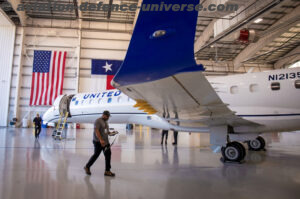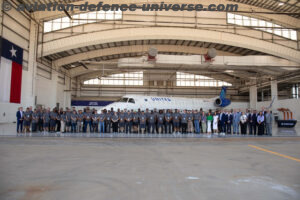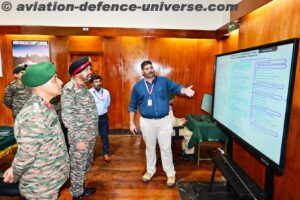- Challenges galore threaten MROs
- Government unable to reap benefits from the MRO industry
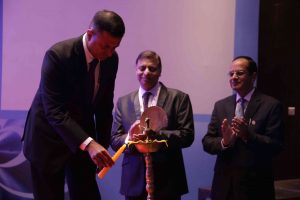
By Sangeeta Saxena
New Delhi. 14 December 2019. It was two days of the who is who of the MRO industry in India rubbing shoulders at Aero India MRO A&D 2019. A classic example of birds of a feather flock together, the annual conference organised by MRO Association of India attracted both Indian and global MRO industry professionals. It was a congregation of Airlines, MROs, OEMs, Supply Chain Managers, Legal Experts, Lease and Finance Experts, Support Services Providers, Bureaucrats, Defence Forces, Design Companies, Aviation Laboratories, Airport Developers and operators, to name a few.
The event was inaugurated by Amber Dubey, Joint Secretary, Ministry of Civil Aviation, Syed Rahman Khadar, IRS, Joint Secretary, GST Council Secretariat, Air Vice Marshal V. C. Wankhade, Dy. SMSO, Maintenance Command, Indian Air Force, R. K. Tyagi, Independent Director, Air India,H. R. Jagannath, Chief Executive Officer, Air India Engineering Services Ltd, Dr. S. Vasudevan, Partner and Head Aviation & Global Lead of Airports, KPMG, Bharat Malkani, President, MRO Association of India and Pulak Sen, Founder Secretary General MRO Association of India.
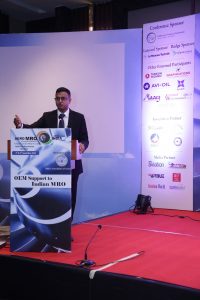
In his inaugural address, Amber Dubey outlines the Ministry of Civil Aviation’s steps towards making India’s Aviation Industry stronger, while Dr. S. Vasudevan charted the growth of the MRO Industry in the coming years, while Syed Rahman Khadar spoke on GST issues for MRO and later on a very interactive session, he elaborately answered the stakeholder questions on GST issues for MRO and Sabka Vishwas – , (Legacy Dispute Resolution) Scheme, 2019 which gives tax relief up to 70 % for the disputes (litigation, arrears, investigations, voluntary disclosure) of Central Excise & Service Tax.
India’s current MRO market size is estimated to be around USD 1.2 billion USD. Major portion of this is A320 family followed by B737,787,777, Q400 and ATR72. Growing commercial aircraft fleet has more than 1000 planes on order by Indian carriers. Use of business jets and helicopters are also likely to increase given demands for chartered services, air-taxis, medical services and disaster management.
Increase in military aircraft as India will continue to replace, upgrade and procure new fleet to address its national defence and home security requirements. Skilled domestic labor force – we produce more than 300,000 engineers and technical graduates every year. The industry employs only about 50,000 today. Competent certified service providers are AIESL which is Air India’s technical division for MRO, Air Works, Max Aerospace, GMR Aero, Indamer, Taj, HAL, Thales, Deccan Aviation, Arrow, Varman amongst others.
There is an untapped resale & redelivery market, a growing market for engines, components and landing gears, which can generate significant value. Adding to these is the technological capability as the industry transforms into using AI, VR and IoT to transform services and customer experience.
Air India Engineering Services Limited (AIESL), a 100% subsidiary of Air India Limited. AIESL is the biggest DGCA approved MRO company in this part of the world, handling variety of aircraft under the Airbus, Boeing and regional jets.
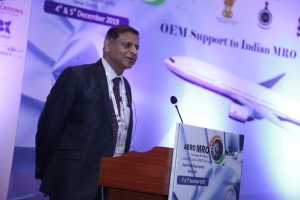
HR Jagannath, CEO AIESL addressing the gathebey, Joint secretary, MOCA
HR Jagannath, CEO AIESL stated , “ we provide line maintenance services at all major airports. Our base maintenance rervices cover major checks for B787, B777, B737 800, B747 400, A 330, A320, ATR 72 & 42 . We have full capability for CFM56 5B, CFM56 7B, V2500 A1 and PW 4000 Engines and partial capability for GE90 & GenX. Integrated 12 bay repair facility for GE 90 & GEnx Engines coming up at Nagpur.”
“ Ours is the only MRO in India equipped with Aircraft Recovery Kit. IATP approved provider of Aircraft Recovery kit and services for India and neighbouring countries. You all will remember the recovery of Turkish Air A330 Aircraft at Katmandu, Nepal by Air India Team in May 2015,” he added.
India, with its growing aircraft fleet, strategic location, pool of engineering expertise and lower labor costs, has a great potential to become a global MRO hub by overcoming the present challenges. Supply chain and logistics improvement will add great value to MRO activities in the country for both an indigenous and a global market.
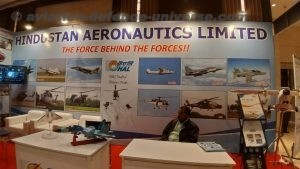
For the military MRO in aerospace it is HAL which gives a single window maintenance support in its overhauling facilities at Kanpur, Lucknow and Engine division, Bangalore. CAR 145 certified maintenance facility for all MRO services are available at Kanpur. AMEs availability training can be imparted by HAL, Kanpur and spares can also be provided by HAL.
“HAL has NABL NAS 410 BARC Safety Council accredited Lab facility, performs Mechanical Testing Non Destructive Testing on parts like Engines, Airframe and Control surfaces and does in situ Radiography Testing of elevator, rudder, flaps, ailerons and landing gears wings. The DPSU also has portable testing facilities available like Dye Penetrant Inspection , Ultrasonic Testing Eddy Current Testing and Radiography Testing, Advance Analysis method for Ultrasonic Testing Technique for monolithic composite parts having different fibres and matrices,” stated Rajesh Singh, Chief Manager (Projects & FA), HAL Nasik.
HAL provides services to Defence customer like IAF, Navy, CG and Non Defense customer like State Government Civil Aircraft Operators and also has the authorisation by Israel Aerospace Industries Ltd . for carrying out NDT on UAV Engines.
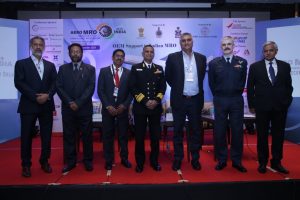
A session on Civil-Military Cooperation where Rear Admiral V M Doss, VSM, Assistant Chief of Naval Staff (Air Material), Indian Navy, Air Vice Marshal V. C. Wankhade, Dy. SMSO, Maintenance Command, Indian Air Force and Shekhar Shrivastava, Chief Executive Officer (Bangalore Complex), Hindustan Aeronautics Ltd. reiterated the need of cooperation between the stakeholders and the Defence Forces. It was moderated by the Bharat Malkani of Max who is also the President of MRO Association of India.
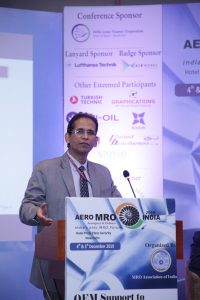
S.K. Rahman, Commissioner (IT & Compliance Verification), Directorate General of Systems, Central Board of Indirect Taxes and Customs
S.K. Rahman, Commissioner (IT & Compliance Verification), Directorate General of Systems, Central Board of Indirect Taxes and Customs delved deep into the GST systems and its advantages to conduct business. He said, “MRO industry is charged an 18% in India and when the aircraft is serviced outside India, the airlines need to pay IGST @ 5%.” He also added, “ trade facilitation is our aim . There is a threshold Limit and we have in mind to extend threshold limit for inter state supply of goods as well and further to extend threshold limit to E – Commerce operators as well.” According to him up to certain limits quarterly tax payments may also be provided to SMEs and there will be a provision for distinction between B2B and B2C invoices.
The stress on brainstorming was majorly on what is hurting the Indian MRO business and the reasons for declining share in Global MRO Business. It is a sad but definite fact that the 3rd largest and fastest growing aviation market in the world is home to about 1% of MRO business globally. A skewed Indian tax structure turned out to be a major culprit. MRO services in India is taxed at 18% while Singapore and Malaysia charge 7% and Sri Lanka none. This takes away a major chunk of work to these nations.
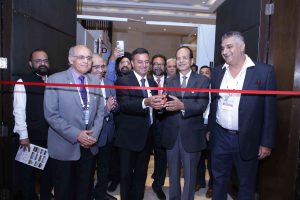
Airport Royalties is another Waterloo for the MRO industry. Airports in India charge royalties on the invoice value of MROs over and above the space rentals paid to the airport companies. As a result of all these hindrances the skilled labor are migrating to overseas markets. Strict regulations on workforce certification and employment norms in India have also added to the reason of this migration. Many workshops have been shut or are bleeding leading to huge job losses in this sector.
What can help turn things around? GST Rationalization which can be a waiver of GST, tax holiday for a five years or nominal GST rate on par with other competing markets is one hope. The other is harmonizing business rules with FAA/EASA – DGCA regulations which should allow clear distinction between training and certification requirements between type-rated and non-type-rated jobs.
Removing royalties is also another factor as it is an additional burden on companies already paying lease rentals with escalation for airport land. If the intent is for the lessor (operator/ authority) to gain the upside, a ten year royalty holiday may be considered in a 50 year lease. This will allow sufficient time for the MRO companies to become mature, competitive and financially self-sustaining. Royalties can be determined through a competitive bidding process. Another factor which is important is levying of duty on imported services which will be OK if status quo on GST or royalties in maintained in order to provide a level playing field though undesirable from a long-term growth perspective.
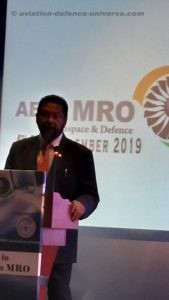
And bright spots on the horizon were the benefits which the MROs give to the nation . It has the potential to create 150,000-200,000 direct jobs in the sector in a potential USD 10 billion industry. It provides an opportunity to employ thousands of engineers and technicians in India. It promotes investment which also results into growth in aircraft fleet. Tax rationalization and regulatory amendments can incentivise more investments in capacity in India from both domestic and foreign investors. Promoting investments and regaining our market share reverses drain in forex and helps consolidate the domestic market for MRO services.
Another benefit is that India can become a net exporter of services as consolidation and market leadership creates a virtuous cycle of growth and investment to help India become a net exporter of services. Generation of tax revenue and multiplier benefits and growth in domestic topline and profits will help generate significant direct and indirect tax revenues giving multiplier effects. Assuming even a conservative tax-to-turnover ratio of 10%, if the industry topline grows to USD 2.5 billion (less than 3% of the estimated global MRO business in 2025), direct andindirect tax revenues could be USD 250 million, which will be far higher than what the government will earn in a declining market under the current tax structure.
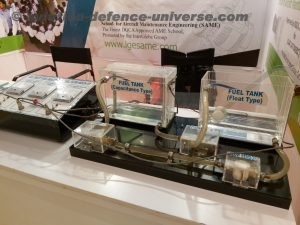
After the two days some points which came forth were that India’s MRO industry has been fighting hard to ensure a level playing field with their overseas counterparts, that today anchor more than 90% of the business created by Indian carriers. Third party MRO service providers have been hard done not just by local taxes and royalties, which are nominal or non-existent in competing markets, but also by regulatory and structural challenges that have resulted in loss of jobs and precious foreign exchange.
With more than 1000 planes in the pipe of Indian carriers and a growing fleet of business jets, choppers and military aircraft, the MRO industry offers a ready platform to kick start growth in a weakening economy. If handled well, it can become a USD 10 billion business, offer employment to the country’s large pool of engineers and technicians and become a net exporter with a clear focus on “Service in India”.






































